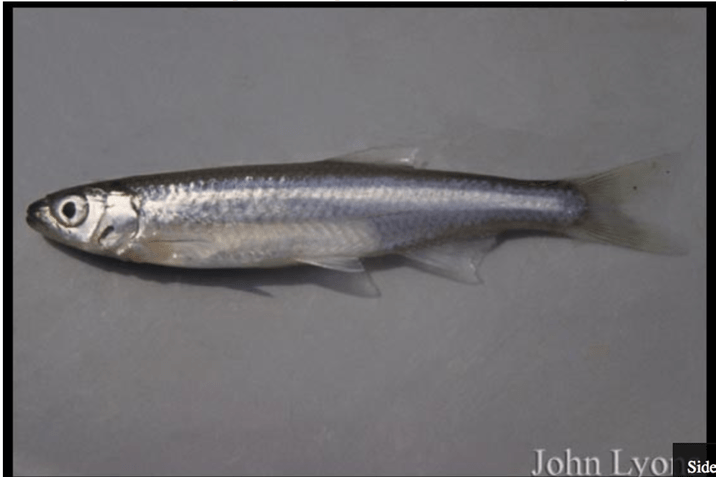Key Characteristics:
- Most pre-anal myomeres than post. But ratio is more even than for Clupeidae and Catostomidae.
- Most have a lateral stripe. Single dorsal fin. Pigment on top of head.
- Very hard to key out to species except for a few unique species until about 20 mm.
- Dorsal fin begins after the start of the pelvic fin.

Larval Emerald Shiner. 10 mm. United States Fish Wildlife Service. Green Bay Harbor, WI. Marian Shaffer. 2018.

Larval Emerald Shiner. 11 mm. United States Fish Wildlife Service. Green Bay Harbor, WI. Adam Dziewa. 2018.

Different Larval Stages of Emerald Shiners. United States Fish Wildlife Service. Marian Shaffer. 2017.
- Body not elongated, eel-shaped, round in transverse section, uniformly pigmented (1B)
- Chin barbels absent (3B)
- Snout short, its length usually less than 10% TL; median fins otherwise (5B)
- Median fins or finfolds showing distinct separation (7B)
- No adipose fin, or demarcation of one, in finfold (10B)
- Preanal myomeres greater than or equal to postanal myomeres (14A)
- Preanal myomeres significantly greater than postanal myomeres (difference greater than five myomeres) (15B)
- Postanal myomeres greater than 10 (26B)
- Preanal myomeres usually less than 30 (28A)
- Cyprinidae (Carps + Minnows)
Adult History
- Physical Description
- Colors consist of blue-greenish back while having a white belly, terminal mouth, No teeth or barbels, 10-12 anal rays, rounded snout and shape, forked tail, rounded lateral-line scales
- Spawning Habitat
- Shoal waters, lower portions of tributaries
- Nearshore and at depths about 3 meters
- Spawning Substrate
- Hard sand and mud (free of detritus) or gravel in streams
- Spawning Behavior
- Broadcast Spawners (no parental care)
- Time of Year
- Early April – Mid-August in the Great Lake Basins
- Spawning typically takes place at water temperatures of 70°F
- Diet
- Omnivores
- Zooplankton, aquatic & terrestrial insects, and algae
- Omnivores

